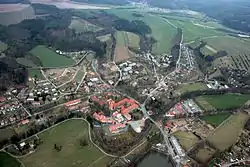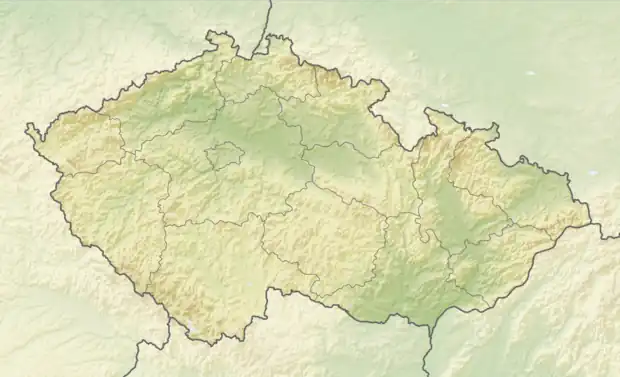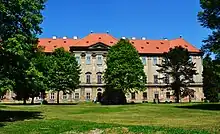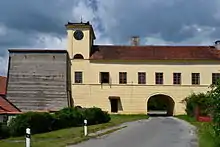Plasy | |
|---|---|
 Aerial view | |
 Flag  Coat of arms | |
 Plasy Location in the Czech Republic | |
| Coordinates: 49°56′5″N 13°23′26″E / 49.93472°N 13.39056°E | |
| Country | |
| Region | Plzeň |
| District | Plzeň-North |
| Founded | 1144 |
| Government | |
| • Mayor | Eva Kantor Pořádková |
| Area | |
| • Total | 57.13 km2 (22.06 sq mi) |
| Elevation | 350 m (1,150 ft) |
| Population (2023-01-01)[1] | |
| • Total | 2,993 |
| • Density | 52/km2 (140/sq mi) |
| Time zone | UTC+1 (CET) |
| • Summer (DST) | UTC+2 (CEST) |
| Postal code | 331 01 |
| Website | www |
Plasy (Czech pronunciation: [ˈplasɪ]; German: Plass) is a town in Plzeň-North District in the Plzeň Region of the Czech Republic. It has about 3,000 inhabitants. It is known for its former monastery of the same name, which is protected as a national cultural monument.
Administrative parts
Villages of Babina, Horní Hradiště, Lomnička, Nebřeziny and Žebnice are administrative parts of Plasy.
Geography
Plasy is located about 19 kilometres (12 mi) north of Plzeň. It lies in the Plasy Uplands. The highest point is the hill Spálená hora at 514 m (1,686 ft) above sea level. The Střela River flows through the town.
History

The foundation of the town is connected with the foundation of the Cistercian monastery. The Plasy Monastery was founded in 1144 by then Prince Vladislaus II. The monastery experienced the greatest development during the reign of King Wenceslaus I, and its property gradually grew to cover 50 surrounding villages. The development of the monastery ended during the Hussite Wars, when it was burned down in 1421.[2][3]
The entire 15th and 16th centuries mean a period of deep decline. After the Battle of White Mountain in 1620, the monastery's financial situation improved, most of it former properties were returned to it, and the construction of new buildings on the monastery grounds began.[2]
The monastery was abolished in 1785 by decree of Emperor Joseph II. In 1826, the monastery building with the whole estate was purchased by Klemens von Metternich, who is buried here in the family tomb.[2][3]
Demographics
|
|
| ||||||||||||||||||||||||||||||||||||||||||||||||||||||
| Source: Censuses[4][5] | ||||||||||||||||||||||||||||||||||||||||||||||||||||||||
Transport
Plasy lies on the railway line heading from Plzeň to Žihle and Most.[6]
Sights
.jpg.webp)

The monastery complex is the most significant landmark of Plasy, protected as a national cultural monument. It contains the former monastery, Church of the Assumption of the Virgin Mary, Baroque granary with the Royal Chapel of Saints Wenceslaus and Mary Magdalene, and abbot's residence. In 1661–1666, the church was rebuilt in the early Baroque style. The new convent building was built in 1711–1740 by Jan Santini Aichel and after his death by Kilian Ignaz Dientzenhofer. Today the complex is open to the public and offers guided tours.[3][7]
The former cemetery Church of Saint Wenceslaus was built in the Gothic style and baroque rebuilt in 1690. After the abolition of the monastery, it was modified into the family tomb of the Metternich family.[8]
Notable people
- Mauritius Vogt (1669–1730), German geographer, historian, cartographer and musician; lived here
- Klemens von Metternich (1773–1859), Austrian diplomat and politician
- Václav Levý (1820–1870), sculptor
- Viktor Stretti (1878–1957), painter
- Rudolf Jung (1882–1945), German Nazi ideologue
- Jiří Kornatovský (born 1952), painter
References
- ↑ "Population of Municipalities – 1 January 2023". Czech Statistical Office. 2023-05-23.
- 1 2 3 "Historie" (in Czech). Město Plasy. Retrieved 2022-09-26.
- 1 2 3 "History of the Plasy Monastery". Plasy Monastery. Retrieved 2022-09-26.
- ↑ "Historický lexikon obcí České republiky 1869–2011 – Okres Plzeň-sever" (in Czech). Czech Statistical Office. 2015-12-21. pp. 11–12.
- ↑ "Population Census 2021: Population by sex". Public Database. Czech Statistical Office. 2021-03-27.
- ↑ "Detail stanice Plasy" (in Czech). České dráhy. Retrieved 2023-06-30.
- ↑ "Cisterciácký klášter" (in Czech). National Heritage Institute. Retrieved 2023-03-30.
- ↑ "Hrobka Metternichů" (in Czech). Město Plasy. Retrieved 2022-09-26.